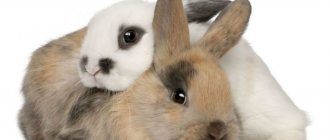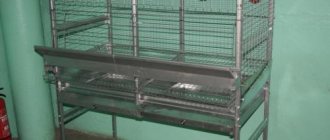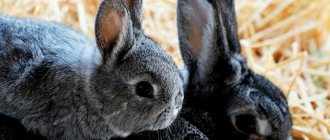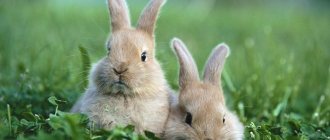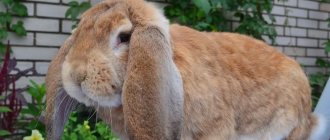A modern farm, being essentially an industrial enterprise, must be equipped with high-quality equipment for rabbit breeding . It is a high degree of automation, with a mandatory high level of reliability, that distinguishes industrial farms from amateur farms. A professional cannot waste time repairing or replacing faulty or short-lived equipment on his farm. Industrial farms cannot stop for repairs for a single day, or even for an hour.
equipment for rabbit breeding that we offer to equip farms includes only high-quality equipment from leading European manufacturers that have long established themselves in this market; it includes the following main elements:
- Modern cage equipment for rabbit farms.
- Automated feeding system.
- Automated drinking system.
- Automated manure removal system.
- Automated climate control system.
Only by using a full set of equipment can sustainable results be achieved with minimal labor costs, so a fully equipped farm for 2-3 thousand productive livestock is serviced by a staff of 1-2 people.
Let us consider the composition of modern equipment for rabbit breeding and its characteristics in more detail.
Cage equipment for rabbit breeding:
RABBIT PROJECTS
|
The basis of a modern rabbit farm is industrial cages.
The most rational solution for the layout of industrial premises is the use of a universal two-level cage of the “Practica FR-231” series. The cage has a number of features associated with the possibility of transformation, which allows it to be used for all production departments, regardless of the stage of the growing cycle. The cages have overall dimensions (1980x2325x1560H), mm.
This cage allows you to automate the processes of feeding and watering as much as possible, and also fully satisfies the requirements of the main production process according to the “empty-occupied” system.
A more detailed description of the cell can be found on the cell description page.
Rabbit cages
Separate cages for rabbits are sectional and multi-tiered devices aimed at breeding and fattening animals. This device is used for industrial rabbit breeding in Russia. The product is easily assembled, turning into a 4-tier product. All parts of the cage are made of galvanized metal, which is protected from moisture and destruction. The pallets are made of stainless steel, therefore they provide reliability and ease of maintenance. These products are convenient for both the animal and the farmer. Lightweight and easy-to-assemble structures can be folded and transported and connected using bolts. In the middle of the cages there are drinking bowls and feed intakes, which are easy to fill with any container.
The presented category of products will ensure the profitability of rabbit breeding at home. These are simple and functional systems for the care and breeding of animals, which can be purchased in our online store. We guarantee quality and long service life of the equipment.
In our online store you can buy cages for rabbits for any purpose; we have many types of cages for breeding rabbits, for fattening and keeping.
Our store offers convenient delivery, and low prices will pleasantly surprise you. For breeding rabbits, we have cages with queen cells, with removable queen cells, cages for industrial breeding, cages with several tiers and many other cages.
With us you can easily select a cage of any type and design depending on the breed, size, and age. Breeding rabbits with the help of our products can take a minimum of time and effort.
Automatic feeding system for cages of the Praktika series
Compound feed is supplied through pipelines equipped with a spiral feed from the silo to distribution bins, which are located at the beginning of each row of cages. Pipelines are routed from each bin into the cages, and a spiral feed is used to distribute the feed portionwise into the feeders. At the operator's request, it is possible to exclude the supply of feed to certain feeders by closing the valves on the pipeline in the appropriate places. The movement of feed granules (pellets) through pipelines is controlled by sensors and switches, which ensure that feed does not fall out from overfilled feeders. The system allows you to use one or more types of feed. The system is driven by electric motors located at the end of each pipeline, i.e. three electric motors for each row of cells. The control unit takes into account the readings of the filling sensors. The general control of the feed distribution system is configured directly by the operator or according to a preset nutrition program, controlling the diet based on the readings of sensors and switches. Electric feed drives are designed for production lines up to 80 m long, but the most rational is the length of cell batteries 40-45 m.
The most important factor for production efficiency is such indicators as the productivity and reliability of equipment used at all technological stages of the rabbit farm.The supplied equipment for rabbit breeding has no analogues in terms of these indicators.
This is due to careful selection, testing and implementation of equipment in our own production cycle.
Equipment for rabbit farm
1 Cell equipment
Two-tier cages for rabbits are manufactured in our own production. The design and materials take into account the strict requirements for livestock keeping conditions. The materials are approved and comply with European standards. Read more…
2 Feeding system
Includes external bunkers for various types of feed, intermediate bins, pipes for feeding feed into feeders with a screw conveyor. The rabbit feeding system is fully automated. Read more…
3 Watering system
To supply water to the cages, special pipes equipped with nipple drinkers are used. Before water is supplied to rabbits, it undergoes preparation. The rabbit watering system is also equipped with medicators.
4 Manure removal system
The manure removal system is optimized and designed specifically for the difficult Russian conditions. All equipment is produced at our own production sites and fully complies with European quality requirements. The manure removal system includes a drainage system. Read more…
5 Climate control system
The microclimate system is designed for Russian conditions and is successfully operating at the pilot enterprise. The microclimate system is fully automated and operates according to specified parameters of humidity, air temperature and air speed. Read more…
6 Artificial insemination
For clear, predictable production, an artificial insemination system is used. Personnel training is being carried out. The laboratory is completed and installed in production.
The high quality of the equipment produced and the high level of training of specialists allowed us to obtain the status of a breeding reproducer of the European leader in the genetics of meat rabbit breeds. Also wins awards at prestigious exhibitions.
The number of amateur and professional rabbit breeders who have chosen our company’s products is growing. Such indicators as: quality, cost, convenience are perfectly combined in OKROL rabbit cage models. The cages are suitable not only for industrial rabbit breeding enterprises, which our company designs and builds, but also for very small farms and farms where rabbits are kept indoors and not outside. The main condition for using cages in private farming is their installation in a warm room. Cages for rabbits have shown their best performance on existing farms, so the number of rabbit breeders using OKROL equipment is growing. Rabbit breeders in the Moscow region, Ivanovo, Kazan, Kostroma, Orenburg, Ulyanovsk, Sverdlovsk, Yaroslavl, and Chelyabinsk regions successfully raise rabbits in OKROL cages.
Automatic watering system for cages of the Praktika series
Water supply is almost always automatic. Automatic water supply makes it easy to do group therapy. Water in the drinking bowl should always be available to animals, it should be fresh, but not cold, the optimal temperature is 15 ° C. Water consumption depends on the quality of feed, ambient temperature, and age of the animal. For an uninterrupted supply of water to the tanks on cellular batteries, a storage tank with a volume of 2 cubic meters must be installed in the technical room of each building; this water is also used to disinfect the room.
In addition, the system allows for the supply of vitamins and medicines; the dispenser is mounted directly on the pipeline and supplies the necessary drugs into the water.
Automatic manure removal system for rabbit farming
Under each row of cells with a slight slope i=0.005 -0.01, channels are installed for removing manure. The channels will be made in two ways: either entirely from reinforced concrete, or using pre-cast reinforced concrete. the site is installed with partitions made of blocks, which then form manure removal channels. The partitions are lined on top with easily washable, non-absorbent ceramic tiles (clinker). The liquid fraction flows down the channels and through the outlet pipe enters the storage tank located underground. Without the liquid fraction, the manure dries out and becomes crusty, while the emission of harmful gases is sharply reduced and the overall microclimate of the room improves. Manure masses, accumulating in a room, allow the room temperature to increase by an average of 5°C in winter and thus spend more energy on heating more economically.
When the channels are sufficiently filled, or in accordance with the production cycle, the solid fraction of manure is removed from the premises as follows: it is necessary to roll the loading ramp to the corresponding hatch of each emptied pit, position the vehicle (or trailer) for transporting manure under the ramp and turn on the electric motor (2 HP). per each pit) of the manure removal drive. The ramp conveyor is also equipped with an electric motor to convey manure into the vehicle body or trailer.
Equipment for keeping rabbits
* rabbits since ancient times. From historical chronicles it is known that in Rus' in the 10th - 11th centuries, downy rabbits were kept in peasant houses and monasteries. For a long time, harem, pit and trench semi-free methods of keeping were used. Despite the simplicity and availability of these methods in modern rabbit breeding, their use is limited due to various diseases, significant waste of young animals, the impossibility of treatment and breeding work. Our and foreign experience clearly shows that now rabbits should be kept only in cages , where it is more convenient to care for them. As you know, there are several systems for keeping rabbits in cages: outdoor, combined and indoor. The first two are better suited for our homestead and small rabbit farms.
Rice . 1 . Cage for outhouse: 1 - frame, 2 - doors of the maternity ward, 3 - feeder for bulk feed, 4 - drinking bowl, 5 - doors of the feed compartment, 6 - feeder for grass and hay, 7 - inclined platform for resting rabbits, 8 - metal mesh 16x48 mm, 9 - curtains, 10 - rest area for the rabbit; 11 - pallet, 12 - queen cell.
Outdoor cage keeping of rabbits is the cheapest way, in which the animals are provided with natural insolation and fresh air throughout the year. With a combined system for keeping rabbits, animals are kept outdoors in cages from early spring to late autumn and only in winter, during breeding and lactation, are they moved indoors. On our farm we use an outdoor cage for keeping rabbits. Cages for rabbits are single-tiered, pitched, wooden or wooden with a metal frame (Fig. 1). Over the years, I have made and tested many cage designs and have come to the conclusion that there does not seem to be an ideal universal cage. At different periods of life, a rabbit needs one or another living space, but he always needs comfort and cleanliness.
Rice . 2. Cage for combined housing: 1 - feeder - nursery, 2 - feeder for root crops, 3 - feeder for bulk feed, 4 - drinking bowl, 5 - slatted lattice, 6 - hole - manhole, 7 - door of the feed compartment, 8 - door of the maternity compartment , 9 - tray with a trench, 10 - container.
For female rabbits, I build two- and three-person cages with inserted queen cells, an inclined floor and a resting area. I make cages from wood. I make the bottom, doors of the annual compartment and feeders for green and roughage from a mesh with a cell of 16x48 or 20x20 mm. The area of each cell is about 1 square. m., and the height is 80 cm, which allows you to keep baby rabbits up to two months of age together with the female. I make an inclined floor from tightly fitted boards around the entire perimeter, and a mesh center for better self-cleaning. At a height of 25 cm from the floor along the semi-perimeter, I make shelves for rest. At first the female rests on them, and when the rabbits grow up, they also jump on them with pleasure.
rice. 3 Feeder for bulk feed
feeders for hay and feed on the door, and I also attach the drinking bowl to the door or front wall. For the winter, I insulate the mesh floor with straw and plywood. During frosty weather with wind, the front part of the cage should be covered with burlap or plastic wrap. For all-season litters, I use universal queen cells, which I make from nail boxes, upholstering them on the outside with fiberboard. If the females rabbit in severe frosts, then I install heaters in the queen cell, which can be made by any rabbit breeder who is familiar with electrical engineering at the level of replacing a light bulb. As a heating element I use a PEV type resistance with a power of 15 W. The mains voltage is 30-36 V, for which I use a step-down transformer. The heater promotes better yield and increased growth energy in rabbits.
Rice. 4 Attaching the drinker
If it is possible to keep rabbits indoors during the winter, you can use cages that are easy to carry (Fig. 2): they are light, compact and can be installed in two tiers. The overlap between the tiers can be slate, roofing felt, linoleum, etc. At the age of two months, I place the rabbits in an enclosure in groups of 25-30 animals. The significant area of the enclosure (6-7 sq. m) and the second floor in them (3-3.5 sq. m) allows the rabbits to move - run, jump, move from one floor to another. Therefore, feed consumption improves and growth increases. After reaching the age of three months, I place breeding males one at a time, and females - 4-5 heads in a cage. I leave the young animals intended for slaughter in enclosures and begin to fatten them.
Rice . 5 . Drinking bowl made of asbestos pipe: 1 - cans - plugs, 2 - windows for drinking, 3 fastenings.
On our farm we also use other equipment: feeders, drinkers, nest boxes. A convenient feeder, in our opinion, is a bunker automatic feeder (Fig. 3). In such a feeder, the feed is not contaminated and is supplied as it is eaten. Although it is somewhat more difficult to manufacture, the costs are offset by convenience, reliability and durability. We also use drinking bowls of various designs. It is difficult to give preference to any of them. In drinking bowls of a simple design (bowls, jars, ceramic drinking bowls), the water quickly becomes dirty and often spills out, so
Rice . 6. Vacuum drinkers: 1 - hoop for attaching a bottle, 2 - bottle, 3 - lid, 4 - tube, 5 - drinking bowl.
they need to be secured (Fig. 4). Automatic drinkers are quite complex to manufacture and are not very reliable in operation. Vacuum drinkers are more reliable. To make them, you can use bottles with a capacity of 1-1.5 liters, asbestos pipes (Fig. 5) and tin cans (Fig. 6). In general, when choosing feeders and drinkers, preference should be given, first of all, to designs that provide better sanitary conditions in the cage.
F. M. Kapelyushny
If you find this article useful, please share it with your friends:
You might be interested in this:
- Heated greenhouse
- Fruit dryer
- Garden cultivator
- Homemade incubator
- Growing vegetables indoors
- Greenhouses for growing vegetables
Climate control system for rabbit farm
There are two main ventilation design schemes: longitudinal and transverse. With a longitudinal ventilation scheme, several exhaust fans or several groups of fans (in large buildings) are installed at the end of the building, which provide the air exchange necessary for each specific production room; the main task of the fans is to remove harmful gases from the animal habitat, as well as to help maintain the required temperature air. If the building is long (more than 50m), additionally install intermediate fans closer to the middle part, or use a transverse ventilation scheme, evenly distributing all the fans along the facade of the building. Fresh air is taken in through adjustable ventilation windows installed on the facade or roof of the building. In both cases, it can be conditionally determined that in winter a heating and ventilation system is used, and in summer a cooling (humidification) and ventilation system is used.
So, we have looked at the basic equipment for rabbit farming that you need to use to achieve maximum results.
Contact our company office
And our specialists will help you select the optimal parameters for all major equipment systems for raising rabbits, as well as develop an optimal scheme for working with livestock according to the “empty-occupied” system.
In addition to the main equipment for rabbit breeding, we supply our customers with spare parts and auxiliary equipment that are not mandatory, but which can significantly facilitate farm maintenance work. These are carts, adapters, tanks, hoses, belts, etc.
